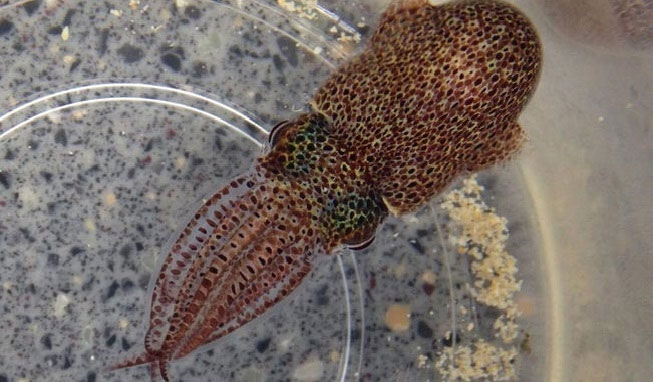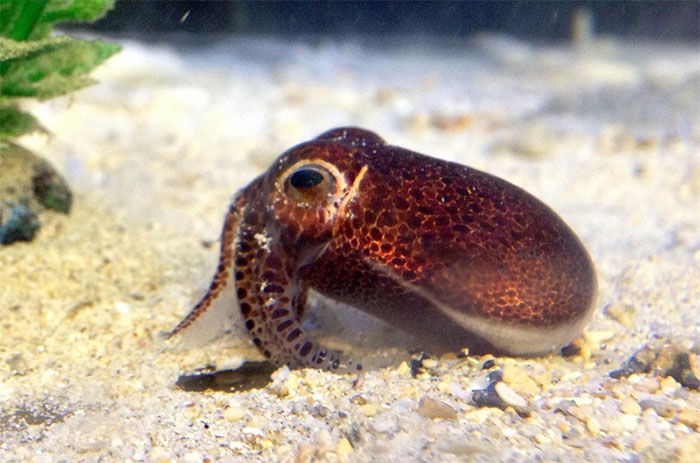New species of squid discovered in Okinawa, Japan
Researchers from the Okinawa Institute of Science and Technology (OIST) in collaboration with a researcher from Australia have identified a new species of squid living in Okinawa waters named Euprymna Brenner in honor of the late Tien Dr. Brenner died earlier this year.
Dr. Sydney Brenner, a South African molecular geneticist who was awarded the Nobel Prize in 2002. He is one of the founders of the Okinawa Science and Technology Institute, which is interested in researching cephalopods. like cuttlefish, octopus and squid. These organisms have complex nervous systems and behaviors, but scientists still know relatively little about them.

This squid has a unique feature that is round dots on the body like beehives.
The findings of the new scientists, published in the journal Biological Communications, highlight the rich biodiversity in the waters near Okinawa, helping to shed light on the genes, behaviors and development of Squid species.
Lead researcher Gustavo Sanchez said: 'Our research tries to understand how the squid's intricate brain works. We also explore why there are so many species off Okinawa. '
Search and categorize a new species
This squid has a unique feature that is round dots on the body like beehives. But they are closely related to the cuttlefish. This species can be bred in a laboratory to study the genetic development and behavior of mollusks.
In the current study, the scientists scoured the shallow waters of the Ryukyan Islands, Okinawa in search of new squid species. They found three different types of eggs and two separate adults.

New species of squid Euprymna brenner.(Photo: Jeffrey Jolly, OIST).
By studying DNA and RNA in 42 different individuals on 10 species of squid, the researchers paired the adults with their corresponding eggs.
From the analysis, the scientists confirmed they found a new species named Euprymna brenner. It is the eleventh known species in the genus Euprymna and this new finding will be useful in future phylogenetic and comparative studies.
Rokhsar, head of the Molecular Genetics Unit at OIST, said: 'It is an honor to name this new species after him as a reminder of his importance in creating the field of biology. molecular, and more broadly, his efforts to promote the development of science in Okinawa, Singapore and around the world. '
In addition to the evolution of squid species, scientists are also interested in the symbiotic relationship of squid with Vibrio fischeri rod-shaped bacteria residing in squid bags. This squid hides itself in the sand all day, then emerges at night to hunt. They use glowing bacteria to camouflage and catch prey more successfully in the dark.
There is a complex relationship between bacteria and ink, said Dr. Oleg Simakov, co-author of the study. If we understand this relationship, then the Euprymna brenner could be a useful model organism for interactions between bacteria and hosts.
- Newly bizarre glowing squid
- Blood-red squid species are thousands of meters deep
- Giant squid is back in Japan
- Giant squid in Japan
- Discovered giant squid species in the North Pacific
- Video: Detect the purple ink breaking like a toy
- 3 species of squid are labeled giant monsters from birth
- Giant squid appeared again, Japanese people feared
- New exotic squid species
- Discovered strange squid species that can see through and look like alien creatures
- Unbelievably strange sea animals
- Earthquakes were continuous in Japan and the Philippines
- Japan: Strong earthquake off the island of Okinawa
- Species are bloody red in the depths of thousands of meters
 Surprised: Fish that live in the dark ocean still see colors
Surprised: Fish that live in the dark ocean still see colors Japan suddenly caught the creature that caused the earthquake in the legend
Japan suddenly caught the creature that caused the earthquake in the legend A series of gray whale carcasses washed ashore on California's coast
A series of gray whale carcasses washed ashore on California's coast Compare the size of shark species in the world
Compare the size of shark species in the world